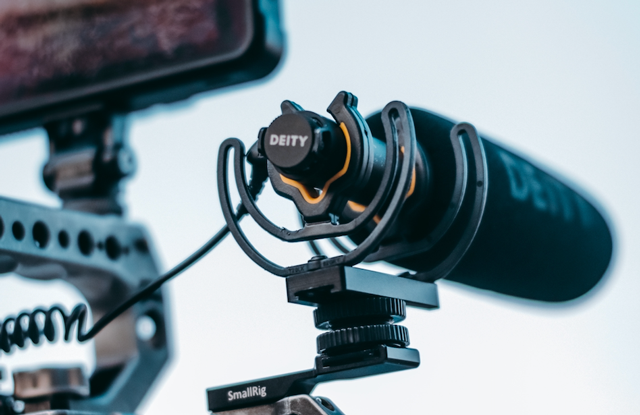 Membership TodaySign Up Now
Membership TodaySign Up NowMicrophone Options for Videos Ads
One of the most important things when it comes to having a high quality video ad that converts, is the audio on your video. Now today, we’re going to be talking all about couple of different types of mics (microphone options for video ads), how to get the best audio possible on your videos and we’ll be demoing a couple mics. I’ll be breaking down which ones we use and in which situations we use them for and also talking a little bit about price. Let’s go ahead and dive right in.
My name’s Justin Sardi, I’m the co-founder and CEO of tubesift.com. And like I said, today we’re going to be talking all about microphones and how to make sure that your video has the best quality audio possible. First things first, we’re just going to go ahead and unplug the microphone that I’m talking on.

Lavalier Microphone
This is the mic that I’m currently using. Oops, there we go. That I’m currently using. This is just a little Lavalier mic and it’s just a wired up mic, usually clips right to the collar and I haven’t unplugged it yet, but basically this just clips right on and you can clip it on your collar, a necklace, something along those lines. We usually just run it right up through, I keep the little amplifier thing. This one’s rechargeable. It’s a MAONO, I’m not sure how to say that. M-A-O-N-O.
But this thing’s just USB rechargeable. It’s got a little battery in here and then this cord runs directly to our camera and hooks up with just a headphone jack essentially. It’s just a little 3.5 millimeter headphone jack sort of like this RØDE does, but we’ll talk about that in a second. This is what we use a lot of times when we are filming just in here, just because nice, easy clips on. It doesn’t matter if I have a wire coming to me, close enough to the camera and this particular mic does a good job of just picking up my voice and not picking up a bunch of other sounds in the area because it is very close. However, it’s not going to pick up Brady as well. If you want to say something, Brady.
[Brady] Yeah, I’m the cameraman over here, it’s not picking me up quite as well probably.
[Justin] Yeah, probably picks him all right because I pointed it towards him. But anyway, this is a mic that we usually use. It mostly picks up me and they don’t pick up a ton of additional audio like some of the other microphones or if we didn’t have this plugged in, the camera would actually just pick up sound from all around the room. If you want to go ahead and unplug that real quick.
I’m still hooked up to this particular mic, the Lavalier mic. One thing about this one, this thing was $20. That’s a very great bargain for somebody just getting started or even professionals, I wouldn’t call us professionals, but no. But it’s a great microphone for beginners and professionals alike, these little Lavalier mics, they’re great. You can actually get wireless ones. I had a really nice set of wireless ones and my puppy chewed them up. But the wireless ones will basically have a little box you keep in your pocket and the receiver and the transponder mount to the camera. It transmits things back and forth. That’s a Lavalier mic. Those work great if you’re just filming one person and you just need one person miked up.
Shotgun Microphone
Then we have the RØDE shotgun mic. Now this is the RØDE video mic, it’s called. This is a shotgun mic. And it’s called that because it’s long, sort of like a shotgun. This is just a little foam. It’s like a windshield for it or windscreen. Essentially this is a condenser mic that’s directional. The way this works is you hook this up to the top of your camera, same kind of audio input, the little 3.5 millimeter jack plugs right into your microphone jack and this mounts to the hot shoe of your camera sitting like this. Now, wherever it is pointed, it’s really just going to pick up the audio in that direction. It’s going to pick up audio just in this much of the space. It won’t pick up anything behind it. It’ll pick up a little bit, but for the most part, it’s directional and it’ll only pick up what the camera is pointing at.
This mounts on top of the camera and wherever you point the camera, it’s going to pick up the audio there. These things work extremely well for a little bit. Obviously not being wired up is a great thing. But when this is just sitting on top of the camera, this’ll pick up audio from pretty far away. This particular RØDE mic, this one was a $150. Pretty good deal for something that works really well. It does have an on off switch, takes some batteries right here. And yeah, this thing works great. Little springy cord. I have a little extender for it in case we want to mount it somewhere else or even just give yourself a little, on our camera, this comes out on the wrong side so we need a little, whatever this is. Just a little extender right here. We use that. But this particular shotgun mic works great. We use these when we’re filming, when I’m speaking at an event or something like that, we use something like this if I’m not miked up.

Handheld Audio Recorder
Then the other one I want to talk about is the Zoom H5. Now this is a really cool audio recorder. This thing has interchangeable capsules so this particular one is a XY stereo mic. It picks up from both directions. You can see right here, it’s got two condensers on it. This particular handy recorder, it’s called, has interchangeable capsules. You can actually get a shotgun mic capsule for this thing. This thing’s really cool. You can buy all the different microphones and basically just, things hook up to it. Really like this one, we use this quite a bit. I used to use this a lot in the past when I was recording things.
The cool thing about this one is it has its own memory cards. It sounds great. Picks up, I can kind of just point it here. If we have two people talking, it’ll pick up both people, because the mics are pointed like that. That works really well. It’s super adjustable. This thing has XLR outputs as well, which is just a different kind of connection. But also you can do a line out just with the regular 3.5 and use an auxiliary cable. This thing is battery powered so you can move it around wherever, you can hook it up to a boom, you get the different capsules. You can change all the levels. This thing was 279, a little more customizable and a little bit higher end.
A lot of people use these for podcasting, things like that. And it does have its own memory card so instead of plugging it into a camera, you can actually set this by somebody, put it over here, wherever you want and it will record audio, saving it onto the memory card. And you can then import that into your video editing software and overlay the audio. You have to sync up the audio obviously, but that’s a really cool feature about this one. And you can also turn the left and the right capsules down so all that good stuff. And like I said, it does have different capsules that you can pop on the top. They’re called capsules. This one is the X Y directional mic. There’s shotgun mics, there’s round microphones. There’s all kinds of good stuff. This is kind of like one of those, it’s a fancy version of those tape recorders where you’re like, hey, note to self. But this is cool, plays back, all that good stuff as well.
You can hook this to the top of your camera and yeah, this thing’s been great. We used to use this quite a bit. Haven’t been using it quite as much because we’re in a smaller area now. Most of the time we are using the Lavalier mic, which happens to be the cheapest one out of all of them, surprisingly.
Microphone Tests
Bottom line is as long as you have some type of microphone to pick up the audio that you want to be picking up, it’s not too bad. We’ll do little audio samples of each of these at the end of this as well. Just kind of show you what they sound like. They’re all going to sound pretty similar. But yeah, bottom line is just use some type of microphone, isolate that voice, the sound, whatever you’re picking up and you will have a much better quality of video.
Here is the Lav mic. Like I said, this one was what? $20, super simple. Test, test, test, test. Test, test, test.
All right, now we will be demoing the shotgun mic. This is the RØDE shotgun mic. You can see, I have no wires hooked up to me, free as a bird. But yeah, that’s what the RØDE shotgun mic sounds like. It’s great for pointing, picking up directional audio. Test, test, test, test. That is that one.
All right, now the third mic that I talked about is the Zoom H5. I’m kind of moving it around so I’m picking up audio a little bit weird, but I am talking with this right now. No wires. That’s the cool thing about it. I could literally just set it right here. You can turn these levels, I actually think we haven’t used this in a minute. I actually think the levels are a little. And I could turn it all the way up to 10 and it’s going to pick up a ton of audio. Really probably where we want that’s about three. But basically as you can see, boom, this is picking up the audio right here and we’ll move it over here. I’ll put it on top of the camera real quick. Just about where it would be.
That’s what it’s going to pick up, from what? Maybe eight feet away. Yeah, that’s the Zoom mic. Again, that one has its own memory card so we don’t actually have to plug it into the camera, which is nice. You can have the camera far, far, far away and be recording audio next to somebody, which is a pretty cool feature. Kind of depends what kind of shots you want to get for that one. But yeah, those are the three types of mics.
That is it for me on this video. If you did like it, please give us that thumbs up, subscribe to us on YouTube. And as always you can jump on over to tubesift.com and sign up for TubeSift and get yourself a TubeSift membership where you can find highly targeted, monetized placements for your YouTube ads. That’s it for me. Bye for now.
 Membership TodaySign Up Now
Membership TodaySign Up NowResources
- Maono Au-100 Lavalier Microphone
- Rode VideoMic (Shotgun Microphone)
- Zoom H-5 4 Channel Handy Recorder
- Getting Started with YouTube Advertising from the TubeSift Blog
- Find Inspiration for your YouTube Ads from the TubeSift Blog



Comments are closed.